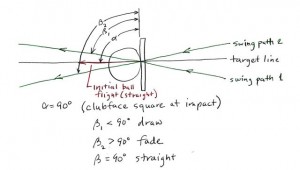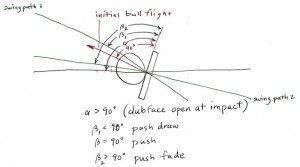I’ve Been Doing It Wrong All Along
For years, I’ve struggled trying to work the ball as the golf instruction books all describe. I’ve just learned that the bulk of the golf instruction books are wrong on how to work the ball. No wonder I’ve been struggling to correct my swing, both on the range and on the course. I’m not athletically incompetent, I’m physics challenged.
For decades, the PGA Teaching Manual has contained some incorrect information pertaining to a golf ball’s flight. That information can be summed up as follows: “The golf ball starts on the direction of the swing path and curves back to where the clubface was aimed at impact.”
Put another way, the Manual has stated that the swing path is the primary, over-riding determinant in the golf ball’s initial starting direction. This information is wrong. It’s been updated (slightly) within recent years, yet many golfers – famous or otherwise – and instructors – famous or otherwise – still believe it.
Just shoot me. Initial ball flight is determined by the club face angle relative to the target line.
I’ve spent 5 years, more or less, trying to learn to swing the golf club, only to learn today that I’ve been correcting my ball flight based on faulty knowledge that the initial direction of the ball is determined by the swing path. I’m having difficulty getting my head around all this, so I had to figure out how to explain it to myself. Here’s what I came up with as an explanation. Warning, there’s a little simple math involved here.
So, as we all know, a square clubface with a inside-to-square-to-inside swing path produces a straight shot. A push is produced by a swing that is inside-to-outside with the clubface square to the swing path at impact. A pull is produced by a swing that is outside-to-inside with a clubface that is square to the swing path at impact. Nothing has changed here.
Draw spin is produced when the clubface angle is closed with respect to the swing path. Fade spin is produced when the clubface is open with respect to the swing path. Nothing has changed here.
A draw is a golf shot that starts straight but curves left (for a right handed golfer). A fade is a golf shot that starts straight but curves right (again, for a right handed golfer — I’ll assume a right-handed golfer from here on out). A push fade is a shot that starts right and also curves right; a push draw is a shot that starts right but curves left. Equivalently, a pull fade is a shot that starts left but curves right, and a pull draw is a shot that starts left and curves left. The way these shots are produced is different than I was taught, and probably how you’ve been taught as well. Let’s delve deeper.
Let’s call the clubface angle relative to the target line alpha ɑ. If the clubface is square to the target line at impact, then ɑ = 90°. Because we now know that the initial path of the ball is determined the the angle of the clubface at impact, the ball goes straight when ɑ = 90°. When ɑ > 90°, the ball starts left (pulls) and when ɑ < 90°, the ball starts right (pushes).
Let’s call the clubface angle relative to the swing path beta β. If the ball goes straight, then there is no draw or fade spin, so the clubface is square, or β = 90°. If the ball draws, the clubface is closed relative to the swing path, and β < 90°; conversely, if the ball fades, then the clubface is open relative to the swing path and β > 90°.
The next diagram shows how the ball reacts when the clubface is square at the point of impact. The ball’s initial ball flight will be straight. If the swing path angle is less than 90°, then this produces draw spin and the ball draws away from the target line. Conversely, if the swing path is greater than 90°, then the ball has a fade spin and the ball fades away from the target line.
The diagram below shows the effect of a closed clubface at impact. The initial ball flight is a pull. If the swing path angle is less than 90°, then the shot becomes a pull draw; if the swing path angle is aligned with the clubface, the shot is a pull, and if the swing path angle is greater than 90°, then the shot is a pull fade.
The last diagram shows the effect of an open clubface at impact. The initial ball flight is a push. If the swing path angle is less than 90°, then the shot is a push draw. If the swing path angle is aligned with the clubface, the shot is a push, and if the swing path angle is greater than 90°, then the shot is a push fade.
Now, we can build a little table to determine why your ball flew the way it did. This will also guide us in figuring out how to hit the shot we want. And this time, have it actually work, because what I was doing before based on multiple golf instruction manuals, was wrong.
Here’s the table.
| β < 90° | β = 90° | β > 90° | |
|---|---|---|---|
| ɑ < 90° | push draw | push | push fade |
| ɑ = 90° | draw | straight | fade |
| ɑ > 90° | pull draw | pull | pull fade |
OK, that’s the table. How do we use it? That’s a topic for another post (coming soon).



